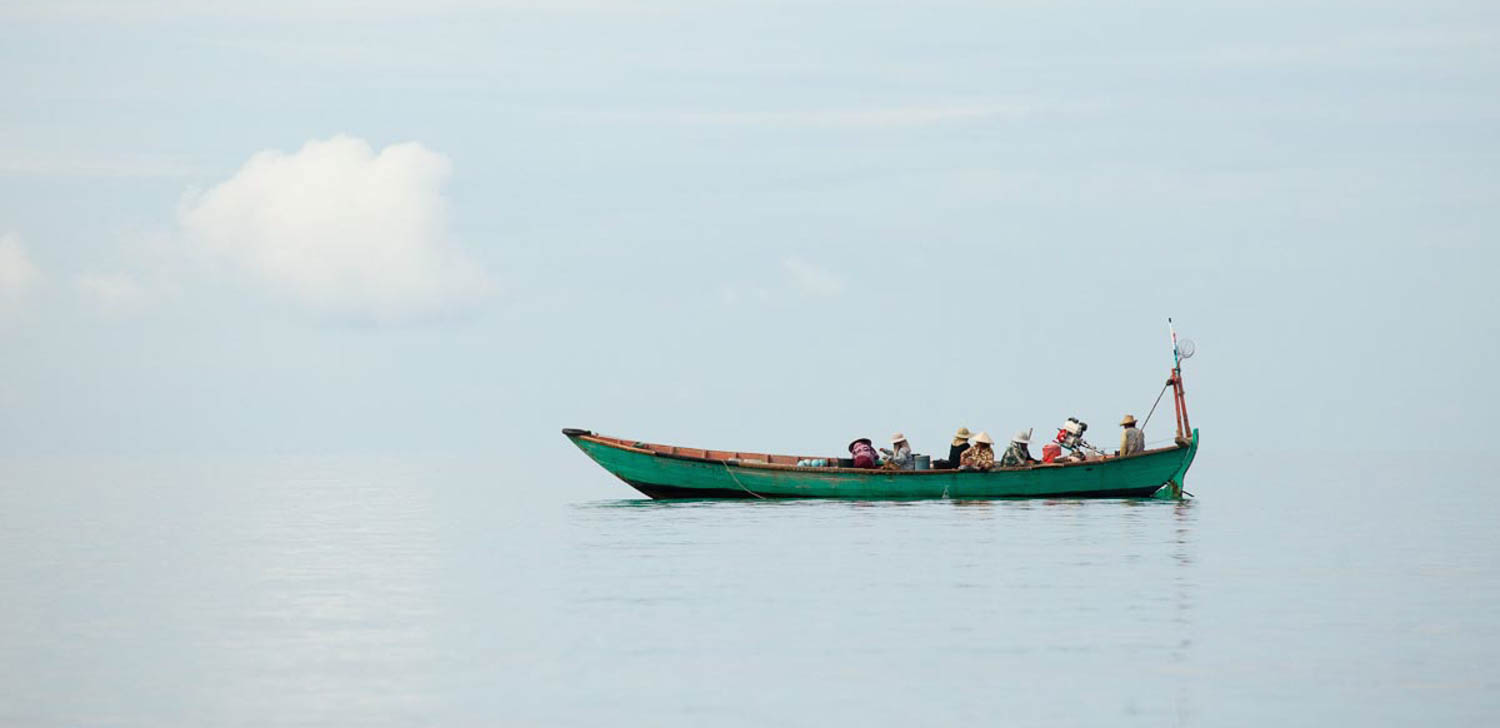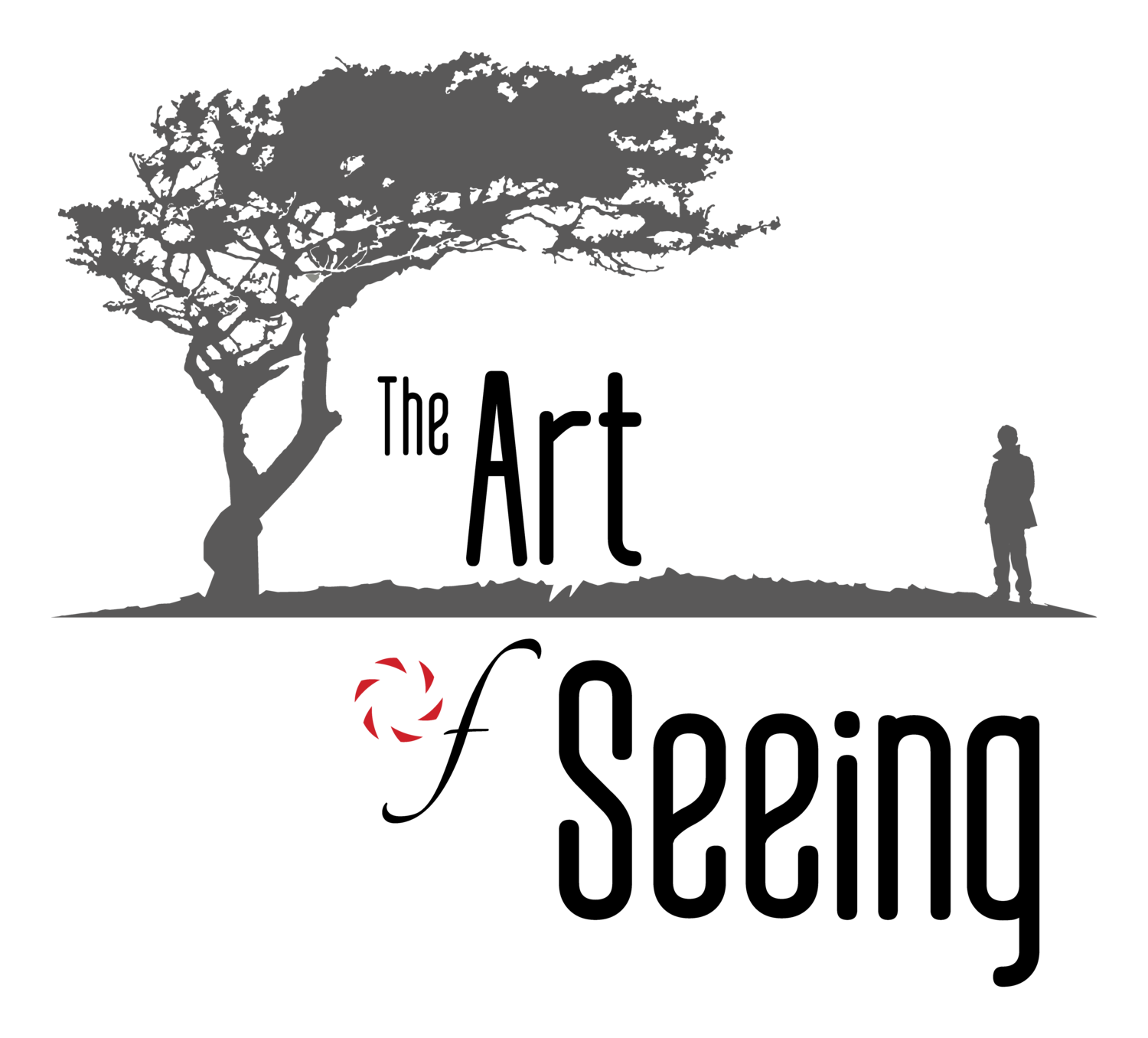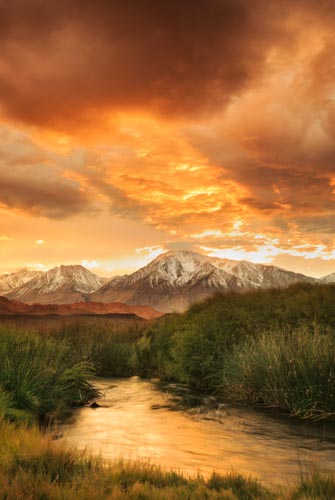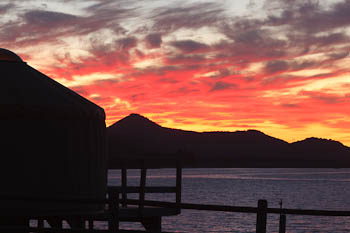
Insights and musings about photography and the creative process
Phone It In. Seriously.
It turns out that the camera in your pocket is a powerful too for developing your Photographer’s Eye and sharpening your creative vision. Since most of the technical decisions are made for you, a phone camera frees you to focus on the image, which, after all, is what really counts.
The other day, on the home stretch of my morning run, I stopped to snap a photo. The dense fog that morning gave everything around Ballona Creek a mysterious, ethereal look. The diffused sun rising across the water looked interesting, so I pulled my phone out of my pocket and clicked a few frames. Hmm, not as cool as it looked, I thought reviewing my images on screen. Oh well. Then I noticed the bridge, that looked cool too. Maybe that will make a better picture. A couple more snaps. I should get lower, I thought. So I picked my way down the rocks lining the creek bank. More snaps...a little better. I need to get home and start my day, I thought climbing back up to bike trail. Just then, a cyclist whizzed by and disappeared into the fog. Wow, that looks cool...just need to wait for another biker. You see where this is going, right? An hour and 159 snaps later I thought, I really have to get home. I ended up with a handful of keepers from that morning, mostly courtesy of a lovely egret hanging out on the docks. So I guess my point is partly about serendipity, which has a way of showing up whenever you follow your instincts. But it’s also about how easy it is to slip into what I call C-mode (creative mode) when you are shooting with your phone. That’s a good thing.
It turns out that the camera in your pocket is a powerful too for developing your Photographer’s Eye and sharpening your creative vision. Since most of the technical decisions are made for you, a phone camera frees you to focus on the image, which, after all, is what really counts. It also removes a lot of the creative pressure of doing 'serious photography', which ironically makes you more creative. I know I feel a lot more instinctive and spontaneous when I'm shooting with my iPhone. For those pixel peepers obsessed with image quality ('IQ'), I agree we haven't reached DSLR quality in our smartphone cameras yet, but let me ask you: How many iPhone billboards did you drive under this week? Those 20X50 foot (printed) images really were shot on a phone. Just how much 'quality' do you need?
One key to making great images with your phone camera is taking an intentional approach when you shoot. In other words, be serious, but don't take it so seriously. Lighten up, but make conscious choices. Pay attention to framing and backgrounds. Try variations. But mostly, give your brain a break and listen to your gut. Look at your images and notice your first reaction but don’t analyze too much. Let yourself be lost in that wordless state where you’re feeling more than thinking. If you can’t remember later what you were thinking when you took those pictures, you did it right.
To see more examples of smartphone camera photos, check out Ken's iPhoneography Gallery
I'd love to see some your favorite phone images. Post a link in the comments or upload your images to Instagram with hashtags #phoneitin and #artofseeing
Seeing in Color
Here's a great (unintentional) example of how color, or more particularly, the color of the light can...
Some like it warm
But maybe you're too cool...
Here's a great (unintentional) example of how color, or more particularly, the color of the light can impact the mood of an image. I went to the Venice Beach Pier the other day to do some scouting for a photowalk I'm leading this weekend. I wanted to catch the last rays before sunset but I got there a little later than planned and the sun was disappearing below the horizon by the time I reached the base of the pier. Looking northwest 'up' the shoreline, the light reflecting off the wet sand caught my eye. I raised my camera, composed and made a few exposures. Pretty standard stuff...but still pretty. Then I turned around and saw that the view 'down' the shore also looked interesting. I especially liked the lines of foam some of the waves made as they rolled onto the beach. I shot a few more frames and moved on. Later, as I was reviewing my haul on the computer, the thing that jumped out at me was the difference in the colors of the two groups of images. The upshore shots which included the sunset sky and its warm light reflecting off the water look completely different than the downshore shots which are dominated by deep blue tones from the twilight sky. The thing is, I made all of these images from basically the same spot just facing different directions, and when I check the time stamps, there's only a 5 minute difference from the first to the the last frame. I won't try to describe the mood of either set of shots or even offer an opinion about which one is 'better'. These are things that are different for each viewer. But it's hard to deny that the two feel dramatically different...and it all comes down to the color of light.
By the way, if you are in the LA area this weekend and want something fun to do, join us for our Venice Beach Photowalk. It's part of Worldwide Photowalk Day. The walk happens on Saturday, Oct 1 and we will start at the base of the Venice Pier at 5pm. Hope to see you there!
Photo of the Day: The Fabric of History
Varanasi is the center of the silk weaving industry in India and much of the work is still done by hand in the surrounding villages. Most weavers...
Varanasi is the center of the silk weaving industry in India and much of the work is still done by hand in the surrounding villages. Most weavers are members of cooperatives that furnish the equipment and raw materials and guarantee a fixed price for the finished products. The looms are usually set up inside the weavers' homes and use a mid-nineteenth century punch card technology known as a Jacquard machine to reproduce complex designs.
Photo of the Day: Reservoir Raindance
It's been some time since Lake Cachuma in the Santa Ynez valley has looked this full and lush. The reservoir, one of the principal sources of drinking water...
It's been some time since Lake Cachuma in the Santa Ynez valley has looked this full and lush. The reservoir, one of the principal sources of drinking water for residents of Santa Barbara, has reached a critically low level due to the ongoing drought in California. This late winter aerial view of Cachuma was made at sunrise during the last year that the area received above average rainfall.
New Meetup Event: Seeing 101
We all instantly recognize good pictures when we see them. Then why is it so hard to capture one with our cameras? Come find out...
We all instantly recognize good pictures when we see them. Then why is it so hard to capture one with our cameras? Come find out the answer in Ken Lee’s presentation, Seeing 101, at the Santa Monica Public Library, Oct 15 at 1:30 pm. Admission is free, but space is limited, so please sign up if you’re coming and try to show up a little early.
You’ve heard of the photographer's eye. It’s the thing that lets some people find amazing photographs in scenes where others see nothing. And as much as technology can dress up mundane pictures, it’s creative vision that’s ultimately at the core of making images with impact. The question is whether you have to be born with this special talent or is it something you can acquire? Ken Lee knows from experience that the ability to fluently speak the visual language that we all innately understand is one that anyone can learn, practice, and develop. Ken calls it the Art of Seeing and he has dedicated himself to helping others learn to see artfully. Ken will share his own ‘aha moment’ story when he suddenly understood the key to making good photographs, the principles behind his Whole Brain approach to learning photography, and plenty of practical tips to help you expand your creative vision. The presentation will run about 45 - 60 mins and there will be a Q&A session afterward. We look forward to seeing you there.
New Workshop! The Art of Seeing: India 2017
Are you looking for an intensive, immersive photography focused adventure? Does the idea of improving your image making abilities in a far off location free from everyday distractions appeal to you? If these things sound like your idea of a good time, then The Art of Seeing: India 2017 Photography Workshop & Tour just might be your ticket. Join me and a small group of photographers March 3-19, 2017 as we capture the colors of the Holi Festival, experience the magnificence of the Taj Mahal and photograph the stars on an overnight desert camel safari. From the chaotic crowds of Delhi to the exhilarating atmosphere of Varanasi heavy with history and spirituality, the opportunities to make memorable photographs
Looking for an immersive photography adventure? Join me on our India photography tour as we capture the colors of the Holi Festival. Learn more today.
My 'Aha' Moment
Up to that point, I had harbored some doubts about whether I really had ‘it' as a photographer…In general, my photographs were technically sound, but totally uninspiring and I knew it. I did have a few photographs I was proud of, but maybe I just got lucky those times.
drawing-right-side
line-drawing
"To look at a thing is very different from seeing it" - Oscar Wilde
Maybe the best way to start off this discussion is to relate how I came to see the light, so to speak. I was in my last year of photography school and a bit annoyed that the instructor of this particular class (Advanced Illustration Photography as I recall) had included "Drawing on the Right Side of the Brain" by Betty Edwards in the syllabus. After all, we were there to learn photography, not how to draw. Up to that point, I had harbored some doubts about whether I really had ‘it' as a photographer. I mean I loved photography, no question. So much so I wouldn't hesitate to call it a burning passion. And I knew the difference between good images and not so good ones. But my own work felt lacking. I had learned well all of the lessons about lighting patterns and contrast ratios and color temperature. I mastered maintaining detail in the shadows and highlights. In general, my photographs were technically sound, but totally uninspiring and I knew it. I did have a few photographs I was proud of, but maybe I just got lucky those times. So there I was, trying to learn how to translate my passion for photography into images with passion, and this instructor wanted me to waste my precious time on a book about drawing. I had no talent in this area and even less inclination to learn. But I couldn't help being totally floored when one of the first exercises I attempted yielded the best drawing I had ever made in my life. The exercise involved copying a picture out of the book with the twist that the picture was presented upside down. Probably the only reason I completed the exercise was that the instructor was literally walking around looking over our shoulders. But when I finished and turned my copy right side up, I couldn't stop staring at the piece of paper in front of me. What I saw was a very reasonable copy of the original drawing and certainly the best drawing I had ever made in my life! Why would drawing a picture upside down make such a difference in my drawing abilities? The answer, it turns out, was that when the drawing was upside down, I couldn't use the stored concepts in my head of what a nose, eyes, mouth, lips, etc. look like. Instead, I was forced to really see what was there.
Betty Edwards is a professor of art that taught drawing for many years and came to the conclusion that everyone has the ability to draw reasonably well, they just need to be taught how to see correctly. Through a series of exercises, she teaches us that there are really two ways of seeing and that looking at things the 'right' (right brain) way is the key to drawing well. I believe it is the key to photography as well. I have also come to believe that what we call art and creativity is just the language of the right brain mode of seeing/thinking. It is a language without words; a language that we all innately understand but sometimes need help speaking. That day in class was a turning point in my approach to photography. I realized then that technique and equipment had very little to do with making good images. Since then, it's been an ongoing journey to better understand the whole creative process and apply the knowledge to my photography. I have come across some great teachers and gained some of my own insights as well. I plan to use this space to discuss this journey. I'd love to hear your thoughts and experiences as well.
Looks Fake, Looked Faker in Real Life
When watching sunrises and sunsets is part of your job description, it's easy to forget the fact you are witnessing a minor miracle a couple of times a day. You tend to get, well, jaded might be too strong a word but let’s call it a connoisseur's disdain for the unexceptional.
When watching sunrises and sunsets is part of your job description, it's easy to forget the fact you are witnessing a minor miracle that happens on schedule, twice a day. Jaded might be too strong a word, but you tend to develop a connoisseur's disdain for the unexceptional. But Mother Nature has a way of reminding you who the real artist is. Case in point, I was walking along the Owens river one fall evening hoping for a 'decent’ sunset to photograph. It wasn't looking too promising as a rapidly thickening blanket of clouds threatened to cancel the event altogether. In the race between the gathering clouds and the setting sun, it looked like the clouds were going to claim the prize. "Looks like it's going to be a bust," I thought but decided to stick it out anyways. As the sun sank to meet the peaks of the eastern Sierra, a golden glow illuminated the entire valley. There was an amazing quality to the light that I’ve only rarely experienced. It felt like the light wasn’t emanating from the setting sun as much as from the air all around me. Then, the sky exploded.
Although I was alone, I'm pretty sure I said "this is unreal" out loud more than once. Then I bent down over the tripod and got to work. I’ve been to this rodeo enough times to know that staying calm is part of the secret to success so I tried my best to adopt a zen attitude. Breathe. Focus. Breathe. Focus. I 'worked the scene' as best as I could, trying various compositions and camera settings, only pausing occasionally to let out a quiet “oh wow." I clicked off a few dozen frames before I knew that the moment had passed. As the light faded, I stopped shooting and watched the final act in reverent gratitude. This, I thought, is why I do this.
Photo Tip: It's O.K. to Look the Other Way
Photographers have been shooting sunrises and sunsets since cameras were invented - we can't help ourselves. This serene scene was my reward for rising early on a Saturday. Cachuma Lake in the heart of the Santa Ynez valley is one of my favorite photo locations in Santa Barbara county.
Photographers have been shooting sunrises and sunsets since cameras were invented - we can't help ourselves. This serene scene was my reward for rising early on a Saturday. Cachuma Lake in the heart of the Santa Ynez valley is one of my favorite photo locations in Santa Barbara county. Although I made this image at the east end of the lake near the inlet of the Santa Ynez River, I was actually facing West (technically slightly Northwest) as I clicked my shutter. This is no anomaly. Whenever I am out shooting at sunrise, I tend to focus my attention to the West. Likewise at sunset you will frequently find my camera pointing East. I do this because I usually want to see the details in the foreground of my photograph, not just a silhouette.
And while it is true that the most dramatic part of the sky is often near the rising/setting sun, the sky in the opposite direction can be even more complex and subtle in its color palette, if a bit less intense. It is also true that techniques such as using split neutral density filters or combining multiple exposures in Photoshop can produce an image with foreground detail looking right into the rising/setting sun. There are many examples of these techniques accomplished with stunning effect. Other times, it can appear a bit forced or unnatural. Another advantage of 'looking the other way' is the gorgeous warm glowing quality of light that illuminates your foreground when you are facing away from the brightest part of the sky (i.e. the direction of the rising/setting sun). I'm really not trying to say one method or direction is better than another. As we know, every sunrise and sunset is unique. The important thing, as always is to really see the scene and then decide how to make your photograph. But you can't see if you don't even look. So next time you're out for a sunrise or sunset photoshoot, resist the urge to automatically point your camera in the direction of the sun. Take time to look the other way...really, it's o.k.
Photo Tip: Use Fuzzy Logic for Sharper Compositons
It’s pretty much an automatic reflex with most photographers to press the shutter button halfway to activate the autofocus as soon as they put their eye to the viewfinder. And why not, what’s the value of looking at a blurry image? Well, there’s a lot of value I think.
It’s pretty much an automatic reflex with most photographers to press the shutter button halfway to activate the autofocus as soon as they put their eye to the viewfinder. And why not, what’s the value of looking at a blurry image? Well, there’s a lot of value I think. In fact, I would say that at this point I do the majority of my composing looking at an out of focus image. As counterintuitive as it might seem this practice really helps me ‘see’ compositions much more clearly. When you look at a blurry image all you can really make out are the major shapes and tones in the frame, which are exactly the elements you want to work with when composing a picture.This technique confounds your left brain’s pesky tendency to suck you into the details and lose sight of the big picture.
In my next post I’ll be writing in depth about the workings of our left and right brain hemispheres. Suffice it to say for now that our left-brain is in love with details, instantly naming and categorizing everything it ‘sees’. Unfortunately, this gets in the way of actually seeing the things we are looking at. You need to be in right brain mode when composing images and looking at a fuzzy scene helps you make that switch. That’s because an out of focus image makes no sense to the left brain – it can’t deal with it. It can’t name its components, there’s nothing to categorize. I like to imagine that the left brain looks at the blurry picture, throws up its hands and walks away.
So next time you are composing a shot, keep your finger off that shutter button. You may even have to manually throw the image more out of focus. Then look at the amorphous shapes and tones in your frame and start making adjustments– there are no rules for this, you just have to try things until it starts to feel right. I know that’s really vague but all I can say is that a good composition feels pleasing visually and balanced while a poor composition does not. Using a tripod is a huge help when you are working this way because it allows you to make small adjustments, then evaluate, then adjust until it ‘works’.
This method is really a corollary to my previous photo tip about looking at small images when shooting or editing to get a better sense of the overall composition, what I call the ‘shape’ of the picture. It’sjust another way of tricking the left brain into stepping aside and letting the right brain do its thing.
I’d love to know what you think about this photo tip. If you found it helpful, you can subscribe to future tips & posts about the Art of Seeing on my homepage.
Good shooting,
-Ken














